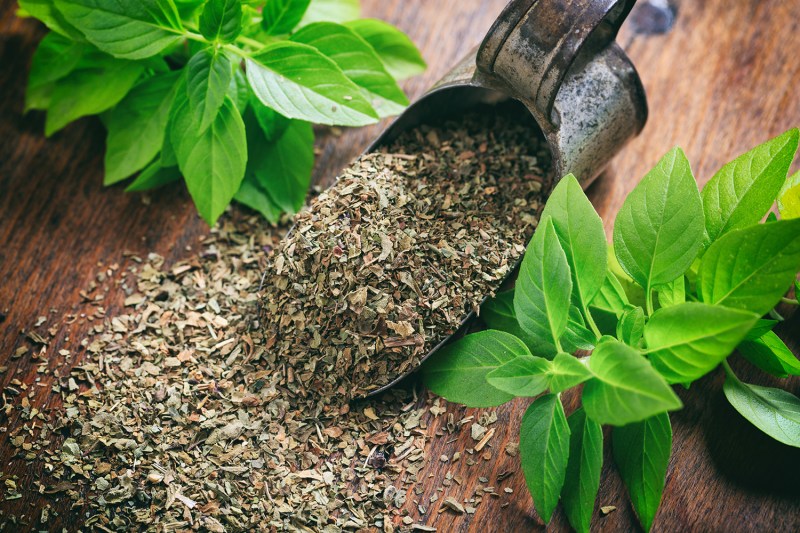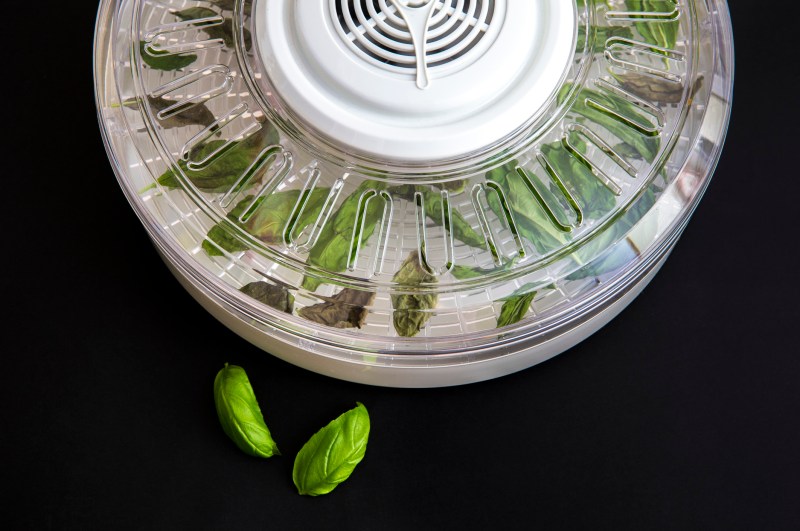
One of the best herb plants to grow indoors is basil. However, basil is a delicate plant and can spoil very quickly once harvested. If you grow an herb or vegetable garden or buy the basil plant at your local grocery store, you will have an overabundance of fresh basil that you need to use or store properly. That’s where we come in! We’ll tell you how to dry basil that is fresh from the garden or store and the best way to store it.
The best ways to dry basil

Drying herbs is just one of the ways to store your leftover basil. There are several ways to dry your basil so you can have it at your disposal any time. If you like fresh basil, then you will love dried basil. It’s much more powerful than the fresh; all that flavor is just crammed into the crunchy leaves.
How to air-dry basil
Air drying is the easiest way to preserve your basil, but it’s a longer process — about two weeks in the summer. This is what you should do:
- Cut the basil’s stems just above the bottom, and be sure to remove blemished leaves.
- Wash it in a bowl of clean water.
- Lay out the stems on a towel to get rid of moisture.
- Put them in bunches of four to five stems and tie them together using a string — don’t overcrowd them.
- Hang them to dry in a dark and dry area, such as your garage or an unused room where there’s no direct sunlight.
- Store your basil in a glass jar or paper bag once it has dried.
You’ll know the leaves are ready when they easily crumble into pieces. You should only crush your herb when you want to use it. Keeping the leaves in their normal size helps to preserve the flavor.
How to sun dry basil
During hot seasons, you can use the sun’s heat to dry your basil. This is the method of drying basil leaves that is the most involved. Here are the steps to follow:
- Pluck the stems and wash your basil gently in running water.
- Harvest the leaves from the stems.
- Spread out the leaves on a drying mat or a wire mesh screen.
- Place the mat or screen outside when the wind is calm.
- Move the drying mat as needed to ensure optimal sun exposure.
This method is better when harvesting large amounts of basil and during the summer months.
How to dry basil in the oven
This is the quickest method for fresh basil to dry. You need to be careful when using the oven to dry basil — low heat is crucial to avoid burning the leaves. Here is how to use the oven:
- Harvest the basil leaves and wash them gently.
- Place them on a cookie sheet or roasting pan in a single layer.
- Leave the pan for about an hour on your countertop to remove moisture.
- Bake the leaves at the lowest heat setting possible — don’t go beyond the recommended temperature.
- Heat the leaves up to 4 hours or until they are thoroughly dried.
While using the oven, be sure to monitor the leaves. They should be crispy and crumbly once they’re dry. Overbaking your basil will ruin its flavor.
How to dry basil in the microwave
Using the microwave to prepare dried basil leaves is also an easy and quick method. Still, you need to be careful when using it. The problem with microwaves is that you can’t dry large batches of leaves. Follow these steps:
- Pluck the leaves and wash and dry them.
- Place the leaves on a paper towel in a single layer — avoid overlapping them.
- Set the microwave to medium power and microwave the leaves for 20 seconds.
- Check the leaves and continue heating them at 10- to 15-second intervals until they’re dry.
While you can microwave the leaves at high power, lower temperatures provide better results. Make sure to monitor the leaves as needed, as microwaves rarely heat things evenly. When the dried basil leaves are crumbly, you can store them.
How to dry basil in a dehydrator
If you have a dehydrator, you can also use it to dry fresh basil leaves. Food dehydrators are perfect for drying herbs since they’re designed to use low heat to remove moisture from dishes. However, it will take longer to dry your basil using a dehydrator than a microwave or an oven.
- Harvest, wash, and air dry your basil leaves.
- Lay out the leaves on a tray in a single layer without overlapping them.
- Use the lowest temperature setting or set the dehydrator at 95 degrees Fahrenheit.
- Inspect the leaves as needed to ensure they dry well.
It will take 4 to 6 hours to dry basil leaves using a food dehydrator, which depends on the leaves’ moisture content. If you have high humidity, it can take up to 48 hours. The best part of using a dehydrator is that you can let it run overnight without worry.
How to store dried basil leaves

Like most herbs and spices, you should store your dried basil leaves in an airtight container away from light. As noted before, dried basil should be stored as whole leaves to preserve flavor quality. You only need to crush them when you want to use them. Still, some people prefer crushing the leaves after drying for easy storage in small jars. Once you fill the jars with basil, be sure to store them in dark areas, such as the pantry and cabinet. You want to keep them away from dampness, light, and heat as much as possible.
How long is basil good for after drying?
Properly dried basil can last for quite a long time, though its flavor potency will weaken over time. For the best flavor and aroma, use dried basil within six months to a year. During this period, the basil retains most of its characteristic peppery and slightly sweet taste. However, even after a year, dried basil won’t necessarily spoil. It’s generally safe to use for longer periods, but the flavor will become weaker and less noticeable in dishes. Some sources say it can last up to three years under ideal storage conditions.
Useful tips about basil

- When using dried basil, use three times less than the amount the recipe calls for in fresh basil. The dried herbs are much more concentrated in flavor.
- When using fresh basil, use three times more than the amount the recipe calls for in dried basil.
- Fresh basil should go in your dish toward the end of the cooking process to retain its flavor.
- Dried basil should go in your dish at the beginning of the cooking process, giving the herb time to rehydrate and flavor your food.



